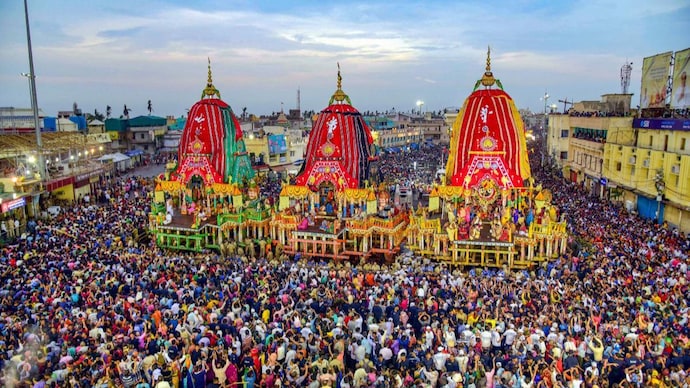Akshaya Tritiya is a yearly Jain and Hindu spring festival. This festival is celebrated on the third tithi (lunar day) of the bright half of the Vaisakha month which is known as Shukla Paksha. Hindus and Jains in India observe it as an auspicious day, which signifies the "third day of unending prosperity".
The word Akshaya means "never decreasing" in Sanskrit, and it is associated with prosperity, hope, joy, and success, while Tritiya denotes the "third phase of the moon". This festival is named after the third lunar day of the spring month of Vaisakha in the Hindu calendar.
The festival is celebrated with great enthusiasm in different parts of India, especially in the southern states of Tamil Nadu and Karnataka, and is also known as "Akha Teej" or "Akti" in some regions.
It is said that any new venture started on this day will be successful and bring good fortune. On this day, people usually buy gold or start new business ventures, make donations to charity, perform puja (worship), and seek blessings from their elders. Some people also observe fasts or perform special rituals and ceremonies to mark the occasion.
Significance in Hindu Tradition
The festival is related to the presentation of the Akshaya Patra to Draupadi by Shri Krishna during the visit of numerous sages, including the sage Durvasa. During their exile in the forest, the Pandava princes were famished due to the lack of food, and their wife Draupadi was pained by this because she could not extend the customary hospitality to their guests. Yudhishthira, the eldest Pandava, prayed to the god Surya, who gave him this bowl, which would remain full till Draupadi served all of their guests. During Durvasa's visit, Krishna made this bowl invincible for Draupadi so that the magical bowl called Akshaya Patra would always remain full with food of their choice, even as to satiate the whole universe if required.
This day holds regional significance for women, regardless of their marital status. They offer prayers for the well-being of the men in their lives or those they may become engaged to in the future. Germinating gram (sprouts), fresh fruits, and Indian sweets are distributed after the prayers. The festival is believed to be even more auspicious if Akshaya Tritiya falls on a Monday (Rohini). Fasting, charity, and helping others are also customary practices observed on this day.
Akshaya Tritiya is also believed to be the day of birth of 6th avatar of God Vishnu, Parashurama. The festival is sometimes known as Parasurama Jayanti by those who celebrate it in honor of Parashurama. According to another legend, this was the day when sage Vyasa began reciting the Hindu epic Mahabharata to god Ganesha.
Akshaya Tritiya is also associated with the visit of Sudama to his childhood friend, Krishna in Dwarka, where he was blessed with unlimited wealth. It is also believed that Kubera was appointed the god of wealth on this auspicious day.
One legend states that the river Ganges descended to earth on Akshaya Tritiya. During the Chota Char Dham Yatra, the Yamunotri Temple and Gangotri Temple are opened on the auspicious occasion of Akshaya Tritiya, after being closed down due to heavy snowfall in the winter months in the Himalayan regions. These temples are opened during the Abhijit Muhurat of Akshaya Tritiya.
Importance in different states:
Akshaya Tritiya holds significance in Odisha as it marks the beginning of the sowing of rice paddy for the upcoming Kharif season. The day commences with farmers performing ritual worship of mother Earth, bullocks, traditional farm equipment and seeds, seeking the blessings of a good harvest. After ploughing the fields, farmers sow paddy seeds as a symbolic start for the most important Kharif crop of the state. This ritual is known as Akhi Muthi Anukula (Akhi - Akshaya Tritiya; Muthi - fistful of paddy; Anukula - commencement or inauguration) and is celebrated with much enthusiasm throughout the state. In recent years, the event has gained publicity due to ceremonial Akhi Muthi Anukula programs organized by farmers' organizations and political parties.
On this day, the construction of chariots for the Ratha Yatra festival of Jagannath Temple in Puri also commences.
In Telangana and Andhra Pradesh, the celebration of Akshaya Tritiya is linked with wealth and benevolence. Simhachalam temple observes particular festive customs on this occasion. The main idol of the temple is coated with sandalwood paste for the remainder of the year, and only on this day, the layers of sandalwood are removed to reveal the underlying statue. The unveiling of the actual form or Nija Roopa Darsanam takes place on this day.
Significance in Jain Tradition
Akshaya Tritiya holds great significance in Jainism as it commemorates the end of the one-year asceticism (abstinence from sensual pleasures) of the first Tirthankara, Rishabhanatha. He ended it by consuming sugarcane juice poured into his cupped hands. This festival is also known as Varshi Tapa by some Jains.
After taking diksha (initiation into the digambar mudra/form), Teerthankar Shri Aadinatha gave up all his wealth and luxuries as the king of Ayodhya, which was made of gold during his time. He then fasted for six months after his deeksha and then started seeking Ahaar for which he continued to Vihar as people during that era did not know about the practice and method of Ahar Daan. This is followed by an event involving Raja Shreyansh who was the younger brother of the king of Hastinapur, Raja Sonprabha. Hastinapur was the prosperous capital city of Kurujangal situated in the southern part of Bharatkshetra.
Story of Raja Shreyash:
As Teerthankar Aadinath was approaching Hastinapur, Raja Shreyansh had seven dreams in one night. In his dreams, he saw a Golden Sumeru Mountain, a Lion, an Ox, the Sun, the Moon, the Ocean, and Vyantar dev who were carrying Ashta Mangal Dravya or Eight Auspicious Elements in front of him. The following day, Raja Shreyansh told his brother King Sonprabha about his dreams, who interpreted them as a sign of a God visiting their house that day. As both the brothers were discussing the results of these dreams with a priest, Lord Rishabhdev entered Hastinapur. After the gatekeeper, Siddharth, informed the brothers that the Lord had arrived in the kingdom, they went to the courtyard and humbly bowed down to him with devotion, performing his Pradakshina. Upon seeing the Lord's form, Shreyansh immediately gained Jati Smaran Gyan (the knowledge of previous births), which also enabled him to recall the rituals of Ahaar Daan from his past births.
In his eighth purva bhav (past birth), Shreyansh was reincarnated as Queen Shrimati, the spouse of King Vajrajangha, who was actually Lord Rishabhdeva in that form. Once, while resting on the bank of a pond in a forest, King Vajrajangha and Queen Shrimati were approached by Muniraj Shriman Damdhar, who was walking in the sky, and another Muniraj named Sagarsen. Both Munirajas had vowed to accept food only in a forest. King Vajrajangha and Queen Shrimati performed the padgahan of both Munirajas and offered them Ahaar Daan through Navdhabhakti. As a result, the Devas performed Panchachcharya. Raja Shreyansh remembered all of this and, understanding the Vidhi, started to perform Ahaar Daan.
The two brothers and their wives performed the Padgahan ritual of Lord Rishabhnath, during which they chanted "He Bhagwan! Namostu, Namostu, Namostu, Atra Tistha Tistha" ("हे भगवन्! नमोस्तु, नमोस्तु, नमोस्तु। अत्र तिष्ठ तिष्ठ") and did 3 pradakshina. Then they offered the Lord to sit on a high pedestal, washed his feet, offered him Puja with eight auspicious elements, and greeted him. Then, they presented the purest form of sugarcane juice to him while reciting, "He Bhagwan! Mann Shudh hai, Vachan Shudh hai, Kaya Shudh hai, Ahaar Jal Shudh hai, Bhojan Grahan Keejiye" ("हे भगवन्! मन शुद्ध है, वचन शुद्ध है, काय शुद्ध है, आहार जल शुद्ध है, भोजन ग्रहण कीजिए।"), which means "O Lord! My mind, words, body, and soul are pure, and this food and water are pure. Please accept this offering."







